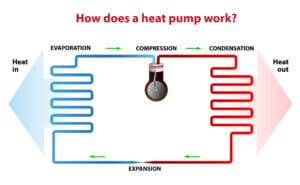Heat Pumps and More: Should You Go Electric for HVAC and Other Home Appliances?
The Case For and Against Gas When It Comes to Green Energy

Lately popular media has focused on the decision by many green energy activists to remove all gas-powered appliances from their homes. With the use of solar panels, battery technology and a heat pump, it is possible, perhaps more so than ever before. Indeed, given the concerns about our world’s dependence on fossil fuels and potential indoor air pollution created by gas-powered stoves, the desire for a greener, healthier home is understandable. The popularity of electric cars has now brought new attention to this energy resource. Really, it shouldn’t come as a surprise that more than 50 cities and counties in California (out of about 580) have now passed some kind of ordinance that either bans appliances that use natural gas in new home construction, or otherwise encourages homeowners to make the switch from, for example, a gas to an induction range.
However, before you start, you should be aware of the realities that accompany making this switch. “But does this make any sense for me and my family?” should be the first question to ask.
Let’s consider heat pumps. The truth is that heat pumps are far better than any and all forms of strip heat; electric furnaces, electric baseboard heaters, strip heat package units, ceiling strip heat etc. Resistance heat converts energy to heat on a one-to-one ratio. Heat pumps don’t convert heat; they move it, from outdoors to indoors (in exactly the same way that air conditioners move heat from indoors to outdoors). This allows them to deliver more heat than strip heat for the same use of energy. The ratio of heat delivered vs. energy consumed is called the “coefficient of performance.” For the better heat pumps, the CoP is around three. So a heat pump will use a third of the energy of a strip heater to bring in the same amount of heat.
So far, so good. But as there usually is when it comes to complicated issues, there’s more.
Strip heat has become rather uncommon in the USA, and is almost nonexistent in California. We banned strip heat in new construction in this state almost 50 years ago. Therefore, the proper comparison for evaluating efficiency isn’t between a heat pump and strip heat; it’s between heat pumps and gas heat that matters.
In a gas vs. heat pump comparison, the CoP still counts. But it isn’t the sole driver. Gas combustion is a source of energy, while electricity is a product of energy. When generating electricity you need some kind of power plant to be the source. That power plant could be solar panels, wind turbines, hydroelectric dams, nuclear reactors or the burning of hydrocarbons (coal or gas) in a power plant. The push for heat pumps in California is an effort to move energy use from hydrocarbons with their carbon footprint to a carbon-free source like wind and solar.
But there’s a complication. With our mild temperatures, Californians run our heat almost exclusively at night. At night, there’s no sun to produce solar power and precious little wind, either. Wind works best at dawn and dusk; warming or cooling landmasses cause the pressure highs and lows that drive breezes. At night, breezes don’t much exist. In short, when heat pumps come on in California, our “renewables” are almost entirely off-line.
Neither nuclear nor hydroelectric generate carbon when they generate electricity. Nor do they care about the time of day. They make good carbon-free sources of electricity for heat pumps. But nuclear is almost gone from California; San Onofre shut down five years ago, and our last nuclear plant at Diablo Canyon is scheduled to close at the end of this year. Hydro is also in decline as drought becomes more and more frequent here.
Sacramento lawmakers will argue that the solution is about more renewables coupled with utility-level energy storage, primarily via batteries. But the amount of battery storage in the state is 500 megawatt-hours, less that 0.1% of our daily electrical usage of 800 gigawatt-hours. As a comparison, the infamous Aliso Viejo gas field in Porter Ranch stores 26,400 gigawatt-hours of energy, enough to electrify the entire state for 33 days. In contrast, our total battery storage can power the state for a total of 66 seconds.
Run the numbers, and you discover that the #1 energy source California uses to generate electricity is. … natural gas. It’s 48% of the total, and much higher at night. Burning gas at power plants involves losing at least 40% of the energy to generation losses. Transmitting it down wires loses another 10%. So you lose half the energy before it gets to the house, costing you most of the benefits a heat pump provides with its Coefficient of Performance.
Here’s the kicker: peak gas prices are one-sixth that of peak electricity prices. Even if the heat pump outperformed gas heat by 3:1 (which it doesn’t) gas is still half the cost. In fact, some pundits say that only way our state will meets its “net-zero” goal in 2030 is by importing power from out of state, including a whole lot of hydrocarbon generated power. Gas appliances will be discouraged, even though future use of expensive, gas-generated electricity from out of state is expected.
So there you have it. It’s a subject that all sides are passionate about, certainly. But look closer and you’ll see compelling evidence for hesitation. As usual, the story behind the headlines is more complicated than it may first appear.
Have questions about switching to electric appliances over gas? Call Air-Tro for more information on all your HVAC choices. (626) 357-3535.
